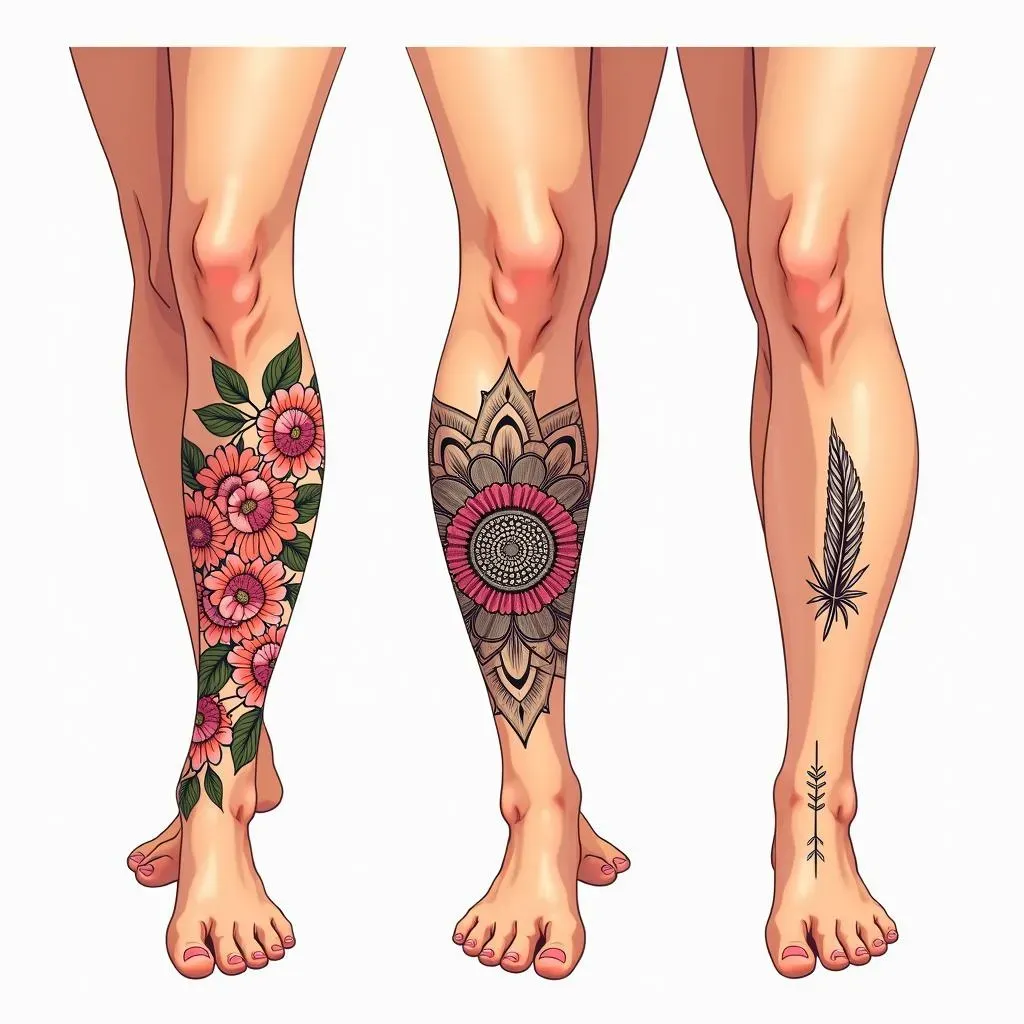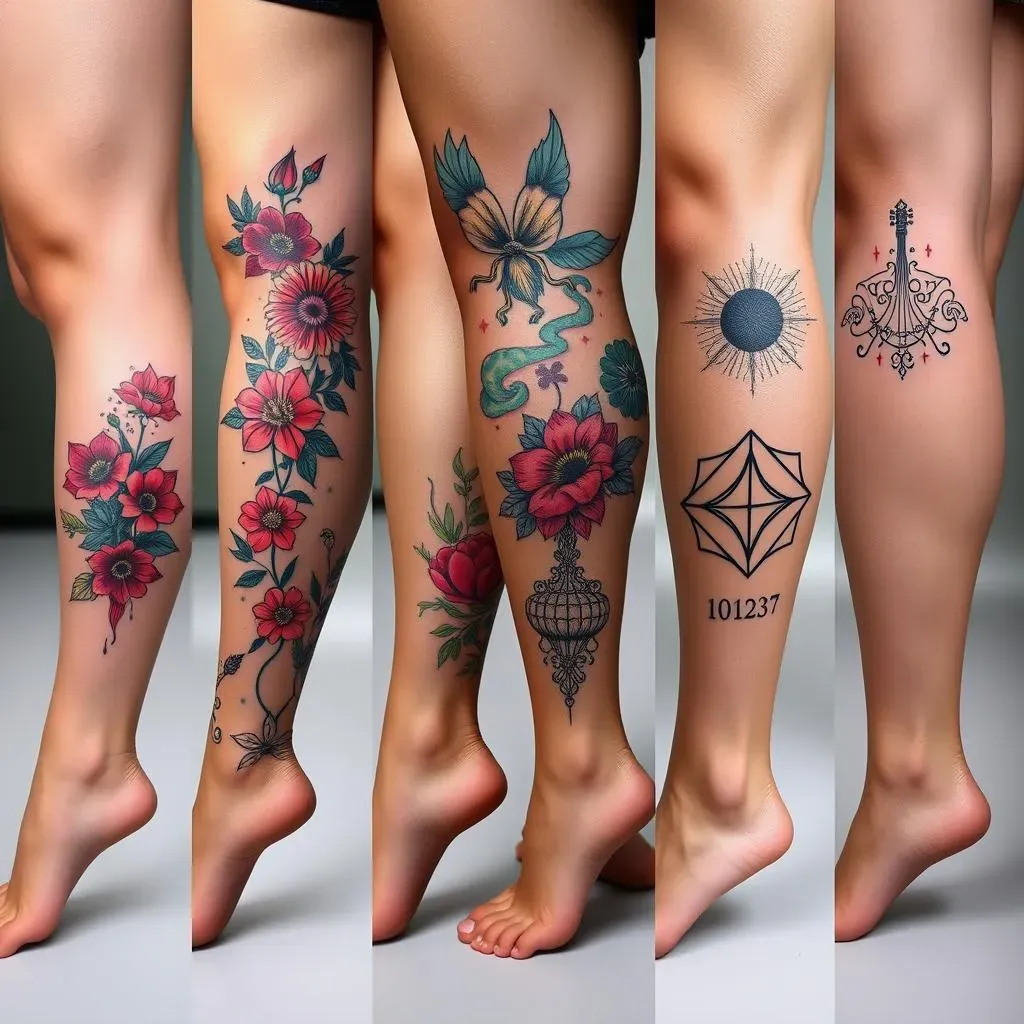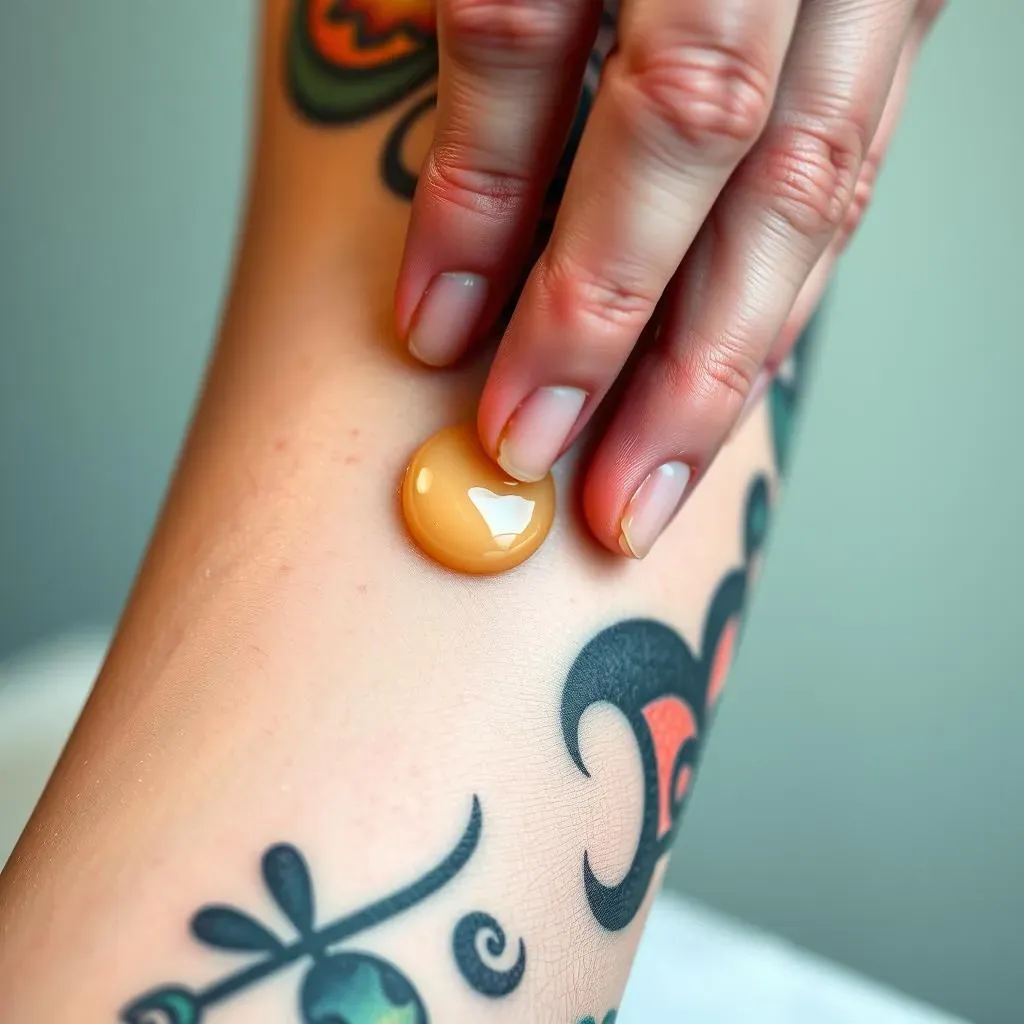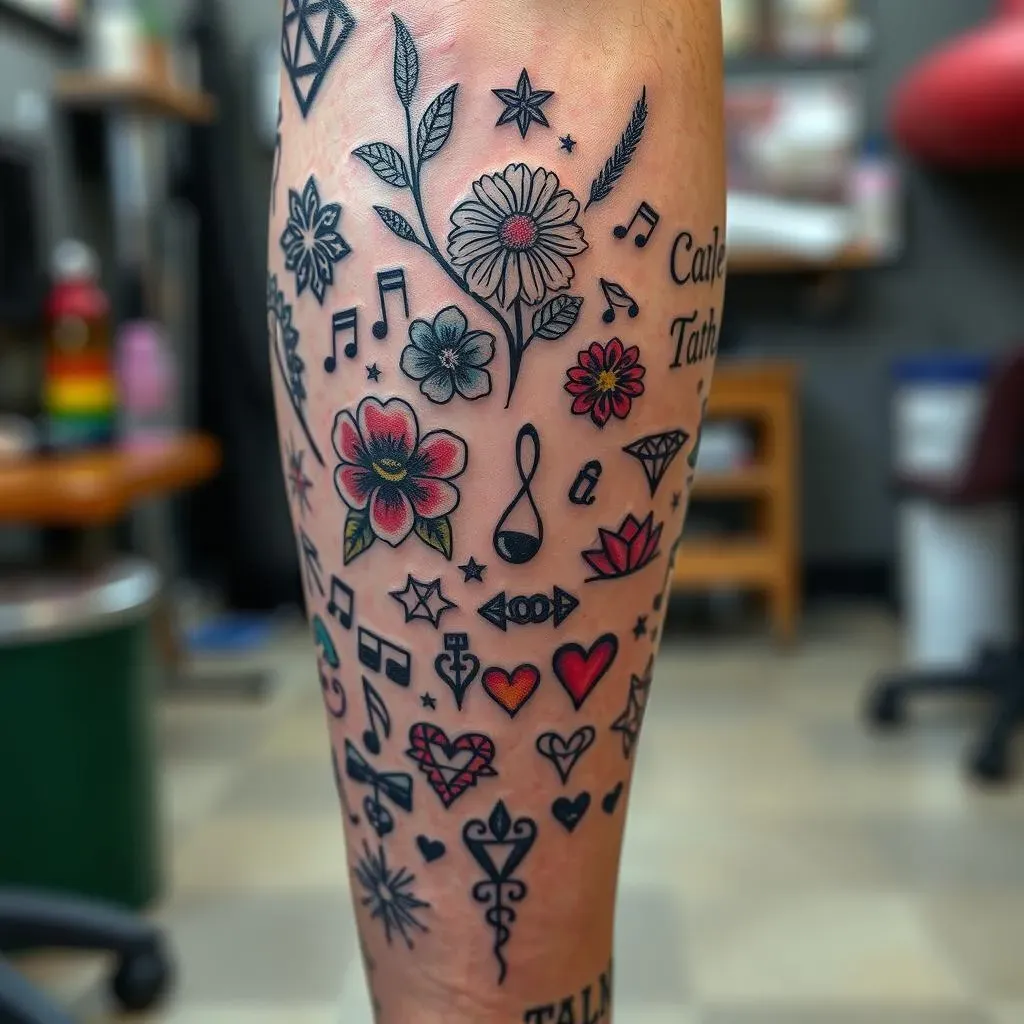Table of Contents
Thinking about getting a leg tattoo? You're not alone. Leg tattoos are a popular choice for self-expression, offering a large canvas for intricate designs or a series of smaller, meaningful pieces. But where do you even begin when figuring out how to design a leg tattoo? This guide walks you through everything, from choosing the perfect placement and design style to understanding the pain factor and mastering aftercare.
Leg Tattoo Placement: Finding Your Perfect Canvas

Leg Tattoo Placement: Finding Your Perfect Canvas
The Calf: A Popular Choice
The calf is a go-to spot for many first-timers and seasoned tattoo enthusiasts alike. It offers a relatively flat and muscular surface, making it ideal for designs that require detail and clarity. Plus, the calf is easily visible, allowing you to show off your ink with pride, especially during shorts season. However, keep in mind that the inner calf can be a bit more sensitive due to thinner skin and proximity to the bone.
Consider the shape of your calf when choosing a design. A vertical design can elongate the leg, while a horizontal design can add width. Wraparound designs are also popular, allowing for a dynamic and flowing look that complements the natural curves of the leg.
Thigh Tattoos: Maximizing Space
The thigh offers a larger canvas compared to the calf, making it perfect for more expansive and intricate designs. Whether you opt for the front, back, or side of the thigh, you'll have plenty of room to work with. Thigh tattoos can be easily concealed or revealed depending on your outfit, giving you flexibility in terms of visibility.
The outer thigh tends to be less sensitive than the inner thigh, which has thinner skin and more nerve endings. Consider this when planning your design, especially if you're concerned about pain. Also, think about how the tattoo will look when you're standing, sitting, and walking, as the skin on the thigh can shift and stretch with movement.
Ankle and Foot Tattoos: Small and Discreet
For those who prefer a more subtle and discreet look, ankle and foot tattoos are excellent options. These areas are ideal for smaller, minimalist designs that hold personal meaning. Ankle tattoos can be easily shown off with sandals or hidden with socks, while foot tattoos offer a unique and unexpected placement.
However, it's important to be aware that ankle and foot tattoos can be more painful due to the proximity of bone and nerve endings. The skin in these areas is also thinner and more delicate, which can affect the healing process. Proper aftercare is crucial to prevent infection and ensure the tattoo heals properly. Also, because of the increased circulation to the feet, the ink can spread more easily, so it is important to find an experienced tattoo artist.
Placement | Pros | Cons |
|---|---|---|
Calf | Good visibility, relatively flat surface | Inner calf can be sensitive |
Thigh | Large canvas, easy to conceal | Inner thigh can be more sensitive, skin stretches with movement |
Ankle/Foot | Discreet, unique | More painful, delicate skin, slower healing |
Designing Your Dream Leg Tattoo: Styles and Inspirations

Designing Your Dream Leg Tattoo: Styles and Inspirations
Finding Your Tattoo Style
so you've picked your spot, now for the fun part: the design! First, think about your personal style. Are you drawn to bold, graphic designs, or do you prefer something more delicate and intricate? Do you like color, or are you more of a black and gray person? Answering these questions will help you narrow down your options and find a style that truly reflects you. Some popular styles include traditional, neo-traditional, watercolor, geometric, and minimalist. Don't be afraid to mix and match elements from different styles to create something unique!
Look at references! Dive into tattoo design images online, social media, or tattoo magazines. Save the images that you love and see if you can find a common style that is appealing to you. Remember that you can always bring multiple references to your tattoo artist, so that they can have a better idea of what you like.
Drawing Inspiration from the World Around You
Inspiration can come from anywhere! Think about your hobbies, interests, and passions. Are you a nature lover? Consider incorporating floral elements, animals, or landscapes into your design. Are you a fan of mythology or folklore? Explore mythical creatures, symbols, or stories. Are you passionate about music or art? Translate your favorite songs, lyrics, or artworks into a visual representation. The possibilities are endless!
Don't be afraid to get personal. A tattoo can be a powerful way to commemorate a loved one, celebrate a milestone, or express your beliefs. Consider incorporating meaningful symbols, dates, or quotes into your design. These personal touches will make your tattoo even more special and unique.
Working with Your Tattoo Artist
Once you have a general idea of what you want, it's time to find a talented tattoo artist who specializes in the style you're interested in. Look at their portfolio and see if their work resonates with you. Don't be afraid to reach out and schedule a consultation. During the consultation, discuss your ideas, show them your reference images, and ask for their input. A good tattoo artist will be able to help you refine your design, suggest modifications, and ensure that it translates well onto your skin.
Remember that your tattoo artist is an expert, so trust their judgment and be open to their suggestions. They can help you choose the right size, placement, and colors for your tattoo. They can also advise you on how to care for your tattoo after it's done. Communication is key to a successful tattoo experience, so don't be afraid to ask questions and express your concerns.
Inspiration Source | Examples |
|---|---|
Nature | Flowers, animals, landscapes, trees |
Mythology/Folklore | Mythical creatures, gods/goddesses, symbols |
Hobbies/Interests | Musical instruments, books, sports equipment |
Personal Symbols | Birthdates, meaningful quotes, family crests |
How Much Does a Leg Tattoo Hurt?: Pain Management Tips

How Much Does a Leg Tattoo Hurt?: Pain Management Tips
Alright, let's get real: how much does a leg tattoo hurt? The truth is, pain is subjective, and everyone experiences it differently. What might be a walk in the park for one person could be excruciating for another. However, there are some general factors that can influence the level of pain you experience. Location is a big one. Areas with thinner skin and more nerve endings, like the ankle and inner thigh, tend to be more sensitive. Bone proximity also plays a role, which is why the shin and foot can be particularly painful. Your pain tolerance, overall health, and even your mental state can also affect how you perceive the pain.
But don't let the fear of pain deter you from getting the leg tattoo of your dreams! There are plenty of pain management strategies you can employ to make the process more bearable. First and foremost, choose a reputable and experienced tattoo artist. They can use techniques to minimize discomfort and ensure a smoother tattooing experience. Also, make sure you're well-rested, hydrated, and have eaten a good meal before your appointment. Low blood sugar and dehydration can increase your sensitivity to pain. Some people find that distractions like listening to music, watching a movie, or talking to their artist can help take their mind off the pain.
Pain Factor | Description | Mitigation |
|---|---|---|
Location | Areas with thin skin, nerve endings, or bone proximity are more sensitive. | Choose a less sensitive area, if possible. |
Individual Tolerance | Pain tolerance varies from person to person. | Be aware of your own pain threshold and communicate with your artist. |
Mental State | Anxiety and stress can amplify pain. | Relax, stay calm, and focus on positive thoughts. |
Leg Tattoo Aftercare: Ensuring a Smooth Healing Process

Leg Tattoo Aftercare: Ensuring a Smooth Healing Process
So, you've braved the needle and now you're sporting some fresh ink on your leg. Awesome! But the journey doesn't end there. Leg tattoo aftercare is absolutely crucial for ensuring a smooth healing process and preserving the vibrancy of your new artwork. Think of it as an investment – you've already invested time, money, and pain into getting the tattoo, so now it's time to invest in its longevity. Proper aftercare can prevent infections, minimize scarring, and keep your tattoo looking its best for years to come. It's not rocket science, but it does require diligence and attention to detail.
The first few days are the most critical. Your tattoo artist will likely apply a bandage or protective film to your new tattoo. Follow their instructions on when to remove it – usually within 24 hours. Once the bandage is off, gently wash the tattoo with mild, fragrance-free soap and warm water. Avoid using harsh scrubs or loofahs, as these can irritate the skin. Pat the tattoo dry with a clean paper towel – cloth towels can harbor bacteria. After washing, apply a thin layer of aftercare ointment or balm to keep the skin moisturized. But be careful not to overdo it – too much moisture can also hinder the healing process. Repeat this washing and moisturizing routine 2-3 times a day for the first week.
During the healing process, avoid soaking your tattoo in water. That means no swimming, baths, or hot tubs. Showers are fine, but keep them short and sweet. Also, avoid direct sunlight, as it can fade the ink. If you must be in the sun, cover your tattoo with loose-fitting clothing or apply a tattoo-safe sunscreen. And resist the urge to scratch or pick at your tattoo, no matter how itchy it gets! Scratching can damage the skin and introduce bacteria, leading to infection. If your tattoo is itchy, try gently patting it or applying a cold compress.
Aftercare Step | Description | Why it's Important |
|---|---|---|
Gentle Washing | Wash 2-3 times daily with mild soap and warm water. | Removes bacteria and prevents infection. |
Moisturizing | Apply a thin layer of aftercare ointment or balm. | Keeps skin hydrated and promotes healing. |
Avoid Soaking | No swimming, baths, or hot tubs. | Prevents bacteria from entering the tattoo. |
Protect from Sun | Cover with clothing or apply tattoo-safe sunscreen. | Prevents fading and damage. |
Patchwork Leg Tattoo Designs: A Unique and Creative Approach

Patchwork Leg Tattoo Designs: A Unique and Creative Approach
What is a Patchwork Tattoo?
so you're thinking about a patchwork leg tattoo design? Awesome! Imagine your leg as a canvas for a collection of individual tattoos, each unique and distinct, but somehow working together to create a cohesive and visually interesting whole. That's essentially what a patchwork tattoo is. Instead of one large, continuous design, you have a series of smaller tattoos, often unrelated in theme, scattered across your leg. Think of it like a curated collection of art, permanently displayed on your skin.
The beauty of a patchwork tattoo lies in its versatility and individuality. You can incorporate different styles, sizes, and colors, creating a truly one-of-a-kind piece. It's a great option for people who have a lot of different tattoo ideas but don't want to commit to a single large design. It also allows you to add to your collection over time, gradually building up your patchwork leg piece by piece. Plus, it's a fantastic way to showcase your personality and interests, with each tattoo representing a different aspect of who you are.
Planning Your Patchwork Leg
So, how do you go about planning a patchwork leg tattoo? The key is to start with a vision, even if it's a loose one. Think about the overall aesthetic you're going for. Do you want a cohesive theme, or are you happy with a more eclectic mix of designs? Consider the size and placement of each tattoo. It's important to leave enough space between each piece to allow them to stand out and avoid overcrowding. Think about the flow of the design as a whole. How do the different tattoos connect and interact with each other? Do you want them to be randomly scattered, or do you prefer a more structured arrangement?
One popular approach is to start with a few key pieces and then fill in the gaps with smaller, filler tattoos. These filler tattoos can be anything from simple shapes and patterns to small, meaningful symbols. They help to tie the different pieces together and create a sense of visual harmony. Another approach is to focus on a specific theme, such as nature, mythology, or pop culture. This can help to create a more cohesive and unified look. Ultimately, the best approach is the one that feels most authentic to you.
Inspiration and Ideas for Your Patchwork
Need some inspiration for your patchwork leg tattoo design? Look around! Pull inspiration from your hobbies and interests. If you love nature, incorporate floral elements, animals, or landscapes. If you're into music, consider musical notes, instruments, or lyrics. If you're a fan of art, translate your favorite paintings or sculptures into miniature tattoos. The possibilities are endless!
Don't be afraid to mix and match different styles and techniques. Combine traditional tattoos with watercolor tattoos, or geometric tattoos with blackwork tattoos. Experiment with different sizes and shapes. Use negative space to create interesting visual effects. And most importantly, don't be afraid to get personal. Incorporate meaningful symbols, dates, or quotes that resonate with you on a deeper level. Your patchwork tattoo should be a reflection of your unique personality and experiences.
Inspiration Source | Example Tattoos |
|---|---|
Nature | Flowers, leaves, trees, animals, mountains, oceans |
Music | Musical notes, instruments, song lyrics, band logos |
Art | Famous paintings, sculptures, geometric patterns, abstract designs |
Personal Symbols | Birthdates, initials, meaningful quotes, religious symbols |
Final Thoughts: Leg Tattoo Design and Beyond
Designing a leg tattoo is a deeply personal journey, blending creativity with careful consideration of placement, pain, and aftercare. Hopefully, this guide has given you the knowledge and inspiration to confidently move forward, whether you're envisioning a sprawling masterpiece or a collection of smaller, meaningful designs. Remember, the best leg tattoo is one that reflects your unique story and style. Take your time, find a skilled artist, and embrace the process. Your legs are about to become a canvas for something truly special.